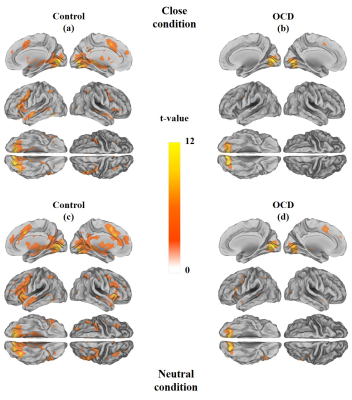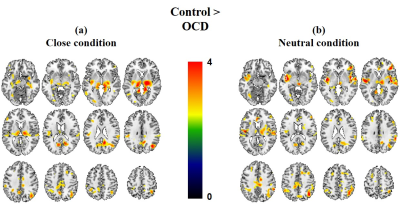1808
Amygdala dysfunction during negative emotional situation in Obsessive-Compulsive Disorder1Department of Medical & Biological Engineering, Kyungpook national university, Daegu, Republic of Korea, 2Department of Psychiatry, Kyungpook national university hospital, Daegu, Republic of Korea, 3GE Healthcare, Seoul, Republic of Korea, 4Biomedical Engineering Research, Kyungpook national university, Daegu, Republic of Korea, 5Department of Radiology and Molecular Medicine, Kyungpook national university, Daegu, Republic of Korea
Synopsis
We investigated brain activation in obsessive-compulsive disorder (OCD) patient using thought-action fusion (TAF) task to assess the influence of OCD symptom on amygdala response to the task. Within and between group analysis of close and neutral condition showed decreased amygdala activation in patients with OCD compared to healthy control.
Introduction
The thought-action fusion (TAF) is a tendency of individuals to blindly establish causal relations between their own thoughts and external reality.1 Many studies have investigated to reveal a reason of transition from normal to abnormal obsessive thought with TAF mechanism.2,3 Despite knowledge of amygdala involvement in fear and anxiety, its contribution to the pathophysiology of OCD remains controversial. In the current study, we used TAF task to reveal amygdala function related to anxiety and mindfulness effect in OCD.Subjects and Methods
A total of twenty-eight participants (14 OCD, 14 healthy controls, all men) were recruited for this study. The mean age of all subjects was 22.21±3.95 (OCD) and 23.57±1.12 (control) years and right-handed in accordance with the Edinburgh handedness scale. During the functional magnetic resonance acquisition, participants were asked to judge how negative feeling they had with the following typed sentence : “I hope that … will soon be in a car accident”. Participants were instructed to complete this sentence by filling the name of a close or neutral (living) person to them (close condition, neutral condition). Functional image data were obtained the 3.0T GE 750W scanner with 24ch head coil (EPI, TR = 2000ms, TE = 30ms, FOV = 23cm, acquisition matrix = 64 X 64, no gap). The 3D T1-weighted fast spoiled gradient echo were used for structural imaging acquisition. fMRI data image processing and statistical analyses used SPSS and SPM8. In fMRI data within-group analysis, maps of brain activation for each condition from the analysis by one-sample t-test. The SPM{t} was thresholded at P<0.01, false discovery rate (FDR) corrected for multiple comparisons across the whole brain. The differences of brain activation between the group were analyzed by two-sample t-test and SPM{t} was thresholded at P<0.01, p-uncorrected.Results and Discussion
In one-sample t-test, the OCD group showed only visual cortex activation in both condition. By comparison, the control group showed salience network activation in both condition (Figure 1). Behavior performance of the TAF task showed significant differences between control and OCD (Figure 2). In the close condition, the OCD group used more reaction time than the control group. In both condition, the control group felt more negative emotions than the OCD group. In addition, OCD group showed decreased activation compared with the control group in both conditions (Figure 3). There was no significant increased activation in OCD group. In particular, when a person with a close relationship entered the negative sentence, the OCD group showed decreased salience network activation including amygdala compared with control group. Based on our findings, the present study suggests that OCD might have dysfunction to assessment of negative emotional situation.Conclusion
We found that the dysfunction to assessment of negative stimuli might be involved in the formation and maintenance of obsessive thoughts and behavior.Acknowledgements
No acknowledgement found.References
1. Rachman S. Obsessions, responsibility and built. Behav Res Ther. 1993;31(2):149-54
2. Rassin E, Diepstraten P, Merckelbach H, Muris P. Thought-action fusion and thought suppression in obsessive-compulsive disorder. Behav Res Ther. 2001;39(7):757-64
3. Rassin E, Merckelbach H, Muris P, Spaan V. Thought-action fusion as a causal factor in the development of intrusions. Behav Res Ther. 1999;37(3):231-7
Figures


